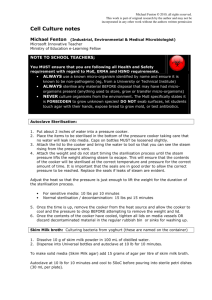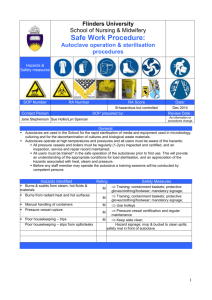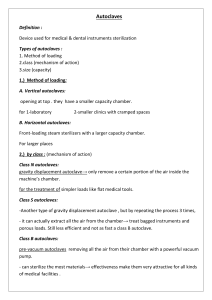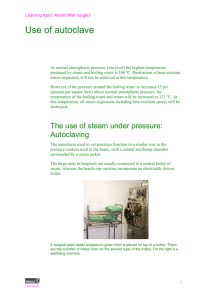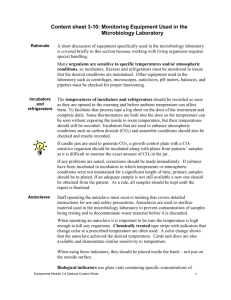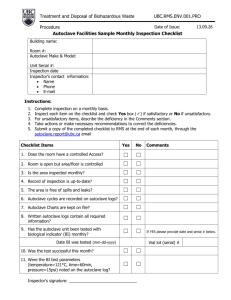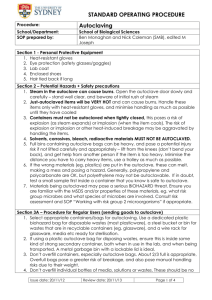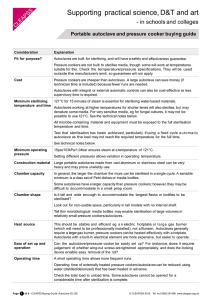Safe Use of Autoclaves - Technician Support Service
advertisement
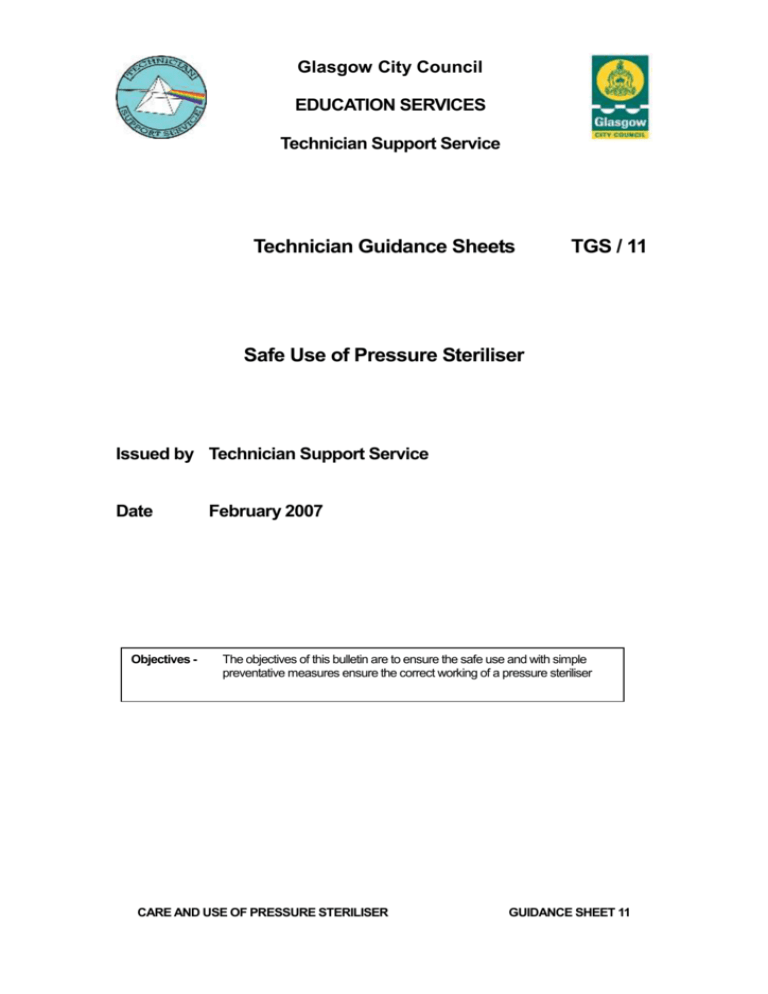
Glasgow City Council EDUCATION SERVICES Technician Support Service Technician Guidance Sheets TGS / 11 Safe Use of Pressure Steriliser Issued by Technician Support Service Date Objectives - February 2007 The objectives of this bulletin are to ensure the safe use and with simple preventative measures ensure the correct working of a pressure steriliser CARE AND USE OF PRESSURE STERILISER GUIDANCE SHEET 11 Safe Use of Autoclaves The purpose of this Guidance Sheet is to provide information on the safe use of sterilising vessels to include autoclaves and pressure cookers. General An autoclave or pressure cooker is an essential item for microbiology. They are used for steam sterilisation but neither piece of equipment can be relied upon if not used correctly. Liquids and articles which would be damaged by dry heat at 1600C are sterilised by steam at 1210C (103kNm-2 or 15lbs in-2 steam pressure) which if held for 15 minutes will kill all micro-organisms including bacterial endospores (126°C for 10 minutes produced in the Prestige Medical Autoclave is equally effective). Regular inspection of autoclaves and pressure vessels are required under the Pressure Systems and Transportable Gas Containers Safety Regulations. It is the responsibility of the employer to make arrangements for these inspections. The services of an outside agency are used by GCC for such inspections. Examination involves checking for signs of physical damage such as cracks or pitting, the normal operation of the pressure release valve and whether any rubber seal or gasket requires replacing. Hazards It can be very dangerous to open an autoclave before the pressure has dropped to atmospheric (when the temperature inside will be about 800 C). The sudden change in temperature caused by opening the vessel before the internal pressure has been allowed to fall has been known to cause violent cracking of glass containers or liquids boiling over and being wasted. Serious scalds and burns have occurred because this hazard has not been appreciated. The cooling period increases the time of exposure to steam and may be necessary for the effective sterilisation of some materials. Heating autoclaves or pressure cookers with Bunsen burners is not recommended. Keep all electrical leads, especially mains leads, tidy and site electrical equipment so as to minimise the risk of water ingress. Ensure that all electrical equipment is inspected on a regular basis by the external inspectors, as arranged by GCC, Education Services. Ensure autoclaves, gas and electric, are inspected on a regular basis by the external inspectors as arranged by GCC, Education Services. Care must be taken to avoid overloading the autoclave as heat and steam will not be able to circulate and complete sterilisation will not occur. Set up the autoclave where there is the least likelihood of injury to oneself or others from the issuing 0 steam or from the trailing cable. The external surface of the autoclave reaches a temperature of 121 C during its operation. Autoclaves with fixed sterilisation cycle can not manually be extended. With larger volumes of cultures or media, it has been found that not enough time elapses for the temperature of the entire medium to be raised sufficiently so that complete sterilisation occurs. In these circumstances, volumes of media must be divided into several smaller batches, preferably in medical flats. Disposal After sterilisation, solid cultures can be disposed of, in tied autoclave bags or similar, via the normal refuse system. Liquid cultures can be flushed away down the lavatory or the sink with lots of water. Additional care must be taken to prevent culture material to accumulate in open or closed waste traps. Clean autoclave chamber internally after use as recommended by manufacturer Clean lid seal with damp cloth and examine to ensure it is in good condition 1 The Autoclave Portable Electric Model A B C D Draw-off Cock Aircock Gauge Safety valve D C B A Checks before use 1. 2. 3. 4. 5. 6. 7. Examine for physical damage The routine Electrical Safety inspection has been made The routine Pressure Systems inspection has been made The lid gasket inside the rim of the lid is free from splits and is flexible The rim of the body on which the gasket seats has no dents That there is a set of instructions for reference at hand Safety valve D should be set to 15lbs in-2 . Adjustment should not be required for normal educational purpose but if required it can be adjusted from 15lbs in-2. to 10lbs in-2. To set to 10lbs in-2 twist until it unlocks and rises. To reset to 15lbs in-2 depress and turn until it locks. Note The pressure vessel should not be allowed to boil dry; if it does so a thermal cut-out switch will be activated. To Re-Set switch off main supply remove contents, empty the container and allow to cool. The cut-out switch is located in the base of the autoclave between the two switches; the technician that is qualified to carryout repairs in school can remove the base plate and re-set the switch. Replace the base plate and check operation. Steam Sterilisation Cycle Heating up Water comes to the boil Free steaming All air must be driven out. Steam should be observed to escape vigorously through the open airlock or steam vent for not less than 2 minutes before the pressure control is operated Holding At least 15 minutes at 121 0C. The timing to start when steam starts to escape with hissing. Turn down the heat shortly after this time but ensure that some steam is escaping throughout the holding period. Cooling Allow to cool naturally; rapid cooling may lead to glassware cracking or liquids boiling over and being wasted Note that the instructions supplied by manufacturers for the operation of their autoclaves may suggest longer holding times or cooling periods than are necessary for effective sterilisation. It would seem that such instructions are erring on the side of safety rather excessively. 2 The following points must be observed using a pressure cooker or autoclave 1. 2. 3. 4. 5. 6. 7. 8. 9. 10. 11. 12. 13. 14. 15. 16. 17. Wear a lab coat and use eye protection. Wear protective gloves when handling hot equipment. Add water to the recommended depth (3cm to the base of the pressure cooker). Place the trivet/stand in the base if required. Loosen caps slightly (tighten then loosen a half turn) on bottles and place the materials to be sterilised in cooker/autoclave. Note that bottles should contain a maximum of 500cm3 of medium and there should be space for expansion above the medium in the bottle. Place Browne's tube/test strip as close as possible to centre of materials to be sterilised. The colour change should be checked at the end of the procedure. Secure the lid of the pressure cooker/autoclave according to the manufacturer's instructions. Heat on an electric or gas ring till steam issues evenly or switch on if the heater is integral. Place on the valve (pressure cooker and some autoclaves). When cooker begins to 'hiss' evenly, turn down heat. Continue heating gently for 15 minutes. Note that steam should continue to issue gently from the valve - if it does not, pressure and temperature are likely to have fallen. The pressure and temperature must be maintained continuously for the recommended time. Steam escaping other than through the safety valve may indicate that the lid is not properly fitted or a worn gasket Turn off heat and allow to cool naturally. Do not attempt to speed up cooling - this can distort the pressure cooker; can cause media to boil over and glass containers may crack. The pressure valve must not be opened until the cooker has reached atmospheric pressure Take care when opening the lid that steam does not escape towards the operator. Allow sterilised materials to cool naturally before removing from the vessel. Lids of screw-capped bottles must be loose to allow equalisation of pressure and for steam to envelope the medium. Failure to loosen lids may result in the bottles exploding due to the increase in pressure. Lids must be tightened once the medium has cooled to appropriate temperature. Cotton wool plugs must be covered with aluminium foil to prevent them becoming wet. Wet bungs will allow organisms to enter the medium and will not filter them out of air passing into containers. All liquids and media except those that are heat sensitive can be sterilised in the pressure cooker or autoclave. Glassware such as Pasteur pipettes and spreaders and autoclavable resistant plastics such as tips for automatic pipettes can be wrapped in foil and autoclaved. If a fault occurs and the unit is not under manufacturers warranty please report it to Technician Support Service for repair. Please circulate this Guidance Sheet to all relevant technicians and teaching staff for information. 3
